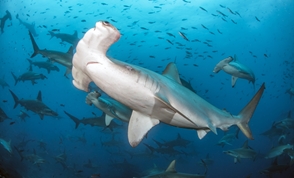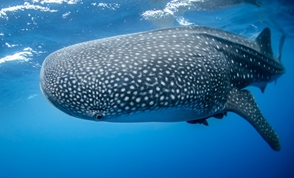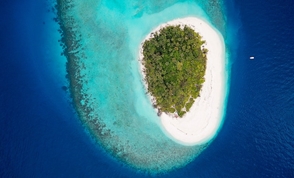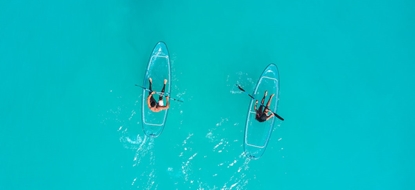The Ultimate Diving Calendar
Planning your 2023 travels? Check out our must-read guide to where to dive around the world, month by month. From schooling hammerheads to mating octopuses, there’s something to float your boat no matter when you choose to take the plunge…
January: Great Hammerheads in Rangiroa, French Polynesia
Great hammerheads tend to be solitary creatures, cruising the oceans in search of a stingray snack (fun fact: they are immune to stingray venom). It can be hard to spot these majestic marine predators, but should you fortunate enough, it’s an unforgettable sight – reaching an eye-popping 20 feet long they are instantly recognisable from their unique T-shaped heads. Your best bet for an up-close encounter is French Polynesia, where they congregate at Rangiroa, one of the biggest atolls in the world. The coral barrier reef at this dreamy outcrop is over 200km long and forms a lagoon as immense as an inland sea. Head to the world-renowned Tiputa Pass in January and you’ll find huge numbers of great hammerheads gathering to feed, along with swooping eagle and manta rays.

February: Whale sharks at Mafia Island, Tanzania
These gentle giants of the sea top every diver’s bucket list. Reaching over 65 feet in length, they are docile filter-feeders who migrate thousands of miles in search of their next meal. In Tanzania, however, rich feeding grounds mean a permanent resident population is thriving in the waters surrounding Mafia Island. Best seen between October and February, the flow of nutrients from the mouth of the Rufiji river draws a huge aggregation of immature male whale sharks, especially at this time of year, making it one of the best places to spot these magnificent animals. At Reefscape Travel, we partner with responsible local operator, Kitu Kiblu, who run daily trips to snorkel with whale sharks in a safe, sustainable and respectful way.

March: Big fish mayhem in the Southern Maldives
The Deep South atolls of the Maldives are the stuff of divers’ dreams. Straddling the equator and bordering the vast Indian Ocean, the three remote atoll islands of Huvadhoo, Fuvahmulah and Addu are a magnet for megafauna and best combined as part of a luxury liveaboard trip. You can expect to see a mind-boggling array of shark species such as tigers, hammerheads, threshers, silvertips and whale sharks, along with a huge range of rays including oceanic mantas. There’s also a good chance of encountering rare pelagic fish such as mola mola and sailfish plus tons of turtles. This is advanced diver territory with strong currents, deep water channels and ocean swells – visit in March for the best conditions and prepare for spectacular interactions with some of the world’s most thrilling marine life.

April: Spawning events in Palau
This far-flung archipelago in the Western Pacific will be firmly on any keen diver’s radar, but did you know that if you time your trip right, you’ll experience one of nature’s most mind-boggling marine spectacles? Plan a liveaboard trip (the best way to dive Palau’s 200 or so islands) to coincide with the full or new moon phases and you’ll be able to witness a unique spawning event. Thousands of fish gather together in the early morning to release their eggs all at once, sometimes turning the water milky. At the full moon it’s bumphead parrotfish who congregate; red snappers at the new moon. The sight in itself is incredible, as vast schools of fish block out the light in a swirling mass of fins, but these spawning events also attract a plethora of marine predators, such as bull sharks, silver tips and oceanic blacktips, who swarm in for a feeding frenzy.
May: Diving Sudan's Deep South
For just a few months each year (before temperatures soar and become unbearable) adventurous divers can join a liveaboard trip to dive Sudan’s seldom-visited, unspoiled dive sites. The most stunning spots lie in the far south of the country, with remote locations and sometimes challenging conditions meaning this is one for experienced divers only. The rewards, however, are great – pristine reefscapes, schools of hammerheads, friendly turtles, huge mantas, silky sharks and grey, black tip and white tip reef sharks.

June: Baitball season in Socorro, Mexico
Wild and remote, Socorro is the largest of the Revillagigedo Islands, cast into the Eastern Pacific some 250 miles south of Cabo San Lucas. Famous among divers for their rich biomass, the islands see an explosion of marine life in June, when vast baitballs of tightly-packed fish form. These in turn lure the big pelagic hunters, such as ten species of shark – scalloped hammerhead, tiger, oceanic white tip, silky, thresher and Galapagos sharks just to name a few. Then there are enormous whale sharks, schools of fast-moving tuna, pods of dolphins, pilot whales and the world’s friendliest mantas.

July: Manta rays at Hanifaru Bay, Maldives
Happy hour at Hanifaru Bay means hundreds of sail-sized mantas gathering for an all-you-can-eat plankton feast. It’s the world’s biggest manta feeding hotspot, with Baa Atoll, where Hanifaru Bay lies, declared a UNESCO biosphere reserve and boasting some of the richest coral reef systems on the planet. Arriving here in their hundreds, the mantas perform balletic barrel rolls as they filter-feed on krill, shrimp and tiny fish. Keep cameras at the ready to catch them cyclone feeding, a truly breath-taking sight as the giant rays form chains as they feed, creating a manta whirlpool. This is a spectacle not to be missed.

August: Humpbacks at Nuarro Lodge, Mozambique
Known for their haunting songs and spectacular acrobatics, Humpback whales are some of the ocean’s most charismatic creatures. During the summer months, they migrate through Northern Mozambique, giving divers the chance to get up close to these immense marine mammals. Nuarro Lodge is one the best places to base yourself. Run on ethical and sustainable principles, this beautiful boutique eco-lodge faces out over the glittering ocean, where humpbacks breach dramatically all day long. On dives from the lodge, you’ll frequently hear their distinctive songs and may even be lucky enough to encounter them in the water.

September: Mola Mola in Alor, Indonesia
Well off the beaten track, the far-flung Alor archipelago in Eastern Indonesia is brimming with an eye-popping diversity of marine life yet sees blissfully few tourists. It’s well worth the effort to get here, as seasoned divers know. Not only are there awe-inspiring wall dives and world-class muck diving, but in September you have a good chance of meeting a mola mola, especially if you plan carefully around the moon phases. The world’s heaviest bony fish, the mola mola or sunfish is a bizarre, blob-like creature that can grow as big as a pick-up truck and weigh 5,000 pounds. Mola in Latin means ‘millstone’, describing its round shape. Harmless to divers, they mostly feed on jellyfish, but can be very curious and will often approach you for a better look – a thrilling experience.

October: Octopus mating season in Dumaguete, Philippines
For photographers and macro lovers, the waters near Dumaguete are heaven. Home to some of the best muck diving on earth, they are teeming with all sorts of weird and wonderful critters. October falls during the rainy season, but it’s worth timing your trip to visit then as this is when cephalopods get frisky. Mating season means that you’ll be able to get up close to wunderpus, blue ring, coconut and mimic octopuses.
November: Oceanic white tips in Egypt
Enigmatic and adrenalin-inducing, Oceanic Whitetips are formidable apex predators who spend their lives cruising out in the open ocean, which makes them hard to encounter. One of the few places where divers can get up close is Elphinstone reef in the Red Sea, a vibrant offshore coral outcrop teeming with marine life, which plummets down to inky depths. Visit in November and you’ll almost certainly spot Oceanic Whitetips, but this isn’t a trip for the faint-hearted. This magnificent shark species is known for its inquisitive nature, so be prepared for curious sharks to circle and approach closely – a thrilling but unnerving experience.

December: Schooling scalloped hammerheads in the Galapagos
Most visitors to the Galapagos come to see the islands’ iconic giant tortoises, but divers know that below the surface lies an even more mesmerising sight. From December to May, you’ll be treated to a magical display as hundreds of scalloped hammerheads form a living wall, their silvery bodies gently undulating like synchronised swimmers. This is one of the few places on Earth that this spectacle can be witnessed, and it’s an absolute corker.












